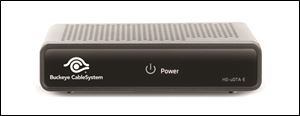
Buckeye making digital switch
Customers will need converter to continue receiving cable
7/19/2014
Buckeye CableSystem customers will need a coverter box, such as this HD DTA box, to continue receiving a signal.
Buckeye CableSystem’s conversion to an all-digital platform is proceeding on schedule with three more customer “hubs” due to begin switching over to a digital-only signal next week, the cable provider said Friday.
By switching to an all-digital system, Buckeye said it will be able to improve picture and sound quality, allow for more channels and more high-definition programming, and be able to utilize other technological advances.
The cable provider’s service areas are divided according to hubs, rather than defined by municipal boundaries or specific geographical borders. Recently, Buckeye completed its digital conversion for customers served by its Owens Community College area, East Toledo, and Oregon hubs.
On Thursday, Buckeye will begin switching customers connected to its Maumee, Perrysburg, and Waterville hubs. The switch will be completed on Aug. 5.
Customers connected to hubs that are due for the digital switch-over are receiving letters and phone calls from Buckeye indicating that the change is imminent.
Brad Mefferd, Buckeye CableSystem’s chief administrative officer, said once the cable provider converts to an all-digital network, it will free up much-needed bandwidth that would allow for additional future services and programming.
“About half of our network is now duplicated by older analog television cable signals,” Mr. Mefferd said. “This [conversion] is going to allow much more of our network to be used for digital services.”
Initially, Mr. Mefferd said, Buckeye will be able to add more high-definition channels, but it also will be able to increase Buckeye Express’ Internet speeds.
In time, Buckeye can provide services for teachers as such services arise, and the system also will be to handle programming for 4K TV, a high-resolution format that takes more bandwidth. “In the future, we could even do telemedicine. That is, you could send readings to a physician via Internet,” Mr. Mefferd said.
Converting to an all-digital platform means that customers will need one of several types of digital converter boxes to receive cable television signals. Buckeye is phasing out older analog cable, meaning that once a hub converts to digital, a TV connected directly to the wall plate via a cable will no longer receive cable signals.
“We’re working our way through the system section by section. We’re kind of stepping through it slowly,” Mr. Mefferd said. “We currently have over 85,000 DTAs already placed in the field.”
DTA stands for digital transport adapter, and an HD (or high-definition) DTA box is one of several options Buckeye is offering customers to make the transfer to the digital platform.
The HD DTA is a small device (about 4.5 inches by 3.5 inches by 1 inch) that receives and translates digital TV signals so that a TV can use them. A cable goes from the wall to the HD DTA box, which in turn has a cable to the TV.
The HD DTA will provide high-definition televisions with HD picture and sound, but it also will work with a non-HD television. It will not provide true high definition to a non-HD TV, but it will provide non-HD televisions with an improved picture.
Buckeye is offering customers the use of two HD DTA boxes free through 2015. After that the cable provider plans to charge a fee for using the boxes but it has not decided on the price. Additional HD DTA boxes are available for $1.95 per month.
In lieu of the HD DTA box, Buckeye customers can also opt for a digital video recorder (DVR) called Buckeye Media Gateway, which costs $18 a month for the first set and $6 a month for each TV after that. Equipment prices are in addition to cable service.
Customers also can rent a high-definition converter box for $11.95 a month for each TV. It receives HD signals for use with an HD TV but has no recording capability.
A fourth option is an SD (for standard definition) DTA for $6.95 per month per TV. It does not get high-definition signals but does receive digital signals.
As the digital switchover begins, customers already using one of the four digital conversion boxes will not notice any change in service.
However, customers who aren’t yet using some kind of digital conversion box (an HD DTA, SD DTA, HD converter, or HD DVR) will notice that some previously available channels will become unavailable.
As the hub switchover is completed, all channels will become unavailable unless a customer has added some kind of converter box.
“At this point, system wide, we only have about 12.5 percent of customers that don’t have any digital boxes,” Mr. Mefferd said. “We know that 12.5 percent will need something or they will be disrupted.”
After the Maumee, Perrysburg, and Waterville hubs switch to digital, the next three hubs slated for the changeover will be in Springfield Township, the University of Toledo area, and a South Toledo area near Arlington Avenue. The changeover will begin Aug. 14 and be finished on Aug. 26.
Mr. Mefford said hubs near the Angola Road area and in Sylvania are slated for changeover in September, while an Alexis Road area hub and a North Toledo hub will be switched in October.
The last hub to be switched serves Bedford Township, and that change will occur in early November.
HD DTAs are available at any Buckeye CableSystem office and also can be ordered online at buckeyecablesystem.com/alldigital. Online orders will be delivered by mail.
Buckeye CableSystem and The Blade are both owned by Block Communications Inc.
Contact Jon Chavez at: jchavez@theblade.com or 419-724-6128.